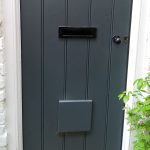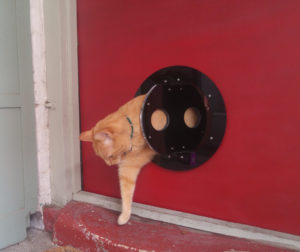Energy Efficiency
Energy efficiency is the goal for every home. Consider the forms of energy householders use, mainly gas and electricity, oil, coal and wood, with niche use of other fuels. All of these fuels come with a cost, both financial and environmental. Aiming for optimum energy efficiency will bring down bills and reduce your carbon footprint.
Some choices you can make through developing good habits at home (more on that later), others are made for you by the manufacturers of the products you buy, the design of the house you live in, the way your working environment is set up and so on. There probably isn’t much you can do about your commuter train running on diesel or your company operating wasteful policies (although it may be worth asking a few questions at work and making some suggestions), but you can affect how you run your home, and make informed choices about purchases.
Energy drains

This is a good idea if you don’t need that catflap.
Energy drains are those areas that you know are inefficient, for instance:
- old or unserviced boilers
- badly fitting windows and doors (link to an article we wrote on the importance of good fitting to meeting energy performance standards)
- a draughty chimney
- a draughty letterbox or catflap
- noisy electrical appliances (especially if they’re frantically running a fan to keep cool)
- poorly-insulated walls and rooves.
- if your house came with a catflap but you don’t have a cat then block up the catflap.
We all use energy-hungry modern appliances including fridges, washing machines, computers and so on. We’d never advocate replacing these for the hell of it as the energy use that goes into making them is a consideration, but when you need to replace an item or you decide the time has come to buy something, look at its energy ratings. There’s plenty of information available pre-purchase, and once you’ve acquired your shiny new computer or washing machine, look at how to use it on the most energy efficient settings.
Then there are the bad habits that reduce your energy efficiency. None in themselves may be that costly but they can really add up, especially if several people live together. These are things like:
- boiling far more water than necessary in the kettle
- repeatedly boiling the same water
- leaving appliances on stand-by
- using a tumble drier other than as a last resort
- not filling the washing machine or dishwasher appropriately before running them
- wallowing in baths rather than nipping into the shower
- leaving lights on (especially incandescent lightbulbs which are so inefficient they’re being phased out).
You can no doubt think of more, especially if you have children!
Improving energy efficiency
There are many steps you can take to improve the energy efficiency of your home. They depend on your budget, your set-up and the period over which you need to see a return on your investment. Making changes to your boiler and heating system or fitting energy efficient windows is a serious investment with a return period of years. However if you have the cash or have obtained a grant, and expect to be in your house for years to come, it will be well worth it. You’ll notice the difference in improved comfort at home and in reduced bills. Similarly buying doors and windows with insulating properties and insulating your walls and roof – it’s an investment but the benefits are immediate.

A typical Victorian house – poorly insulated, expensive to heat and low on energy efficiency
The UK has some of worst-performing housing stock in Europe in terms of energy efficiency. 50% of our housing stock was built before 1960, in the days when energy was cheap, plentiful and dirty. Insulation was rarely built-in as it just wasn’t considered necessary when you could whack up the thermostat. There are many articles on the subject but this from The Guardian although a couple of years old gives a good run-down of the situation.
Sadly more modern housing still lacks the levels of insulation that makes homes really comfortable. Building standards stipulate a shockingly low level of insulation despite improvements in recent years. This leaves a great deal of scope for the householder to add to it. If you can’t afford to fit insulation don’t worry, there are still plenty of energy efficiency measures you can take. In simple terms you want to use as little energy as possible and waste none. Take note of your habits and see what you could do to make the most of the energy you do use.
Tips for the home
Here are a few easy and cheap ways to make your energy spend count:
- fit an Ecoflap to your letterbox (it cuts letterbox draughts, a good move especially if your thermostat is in the hallway near that draughty letterbox)
- switch up from a draughty noisy catflap to a draughtproof Petflap
- block your chimney if you aren’t using it eg with a Chimney Sheep
- fit a curtain over external doors and any that are draughty
- slip a sheet of foil behind radiators to reflect the heat back into the room instead of out through the wall
- lay a chunky ‘sausage dog’-style draught excluder along the base of doors. If you’re handy with a needle make one yourself.
- shut the door to any unused rooms
- after you’ve used the oven leave the door open to let the heat into the room
- use radiator thermostats to keep rooms at an appropriate temperature
- give your computer fan a quick clean from time to time as they can become clogged and then use huge amounts of power to keep going






